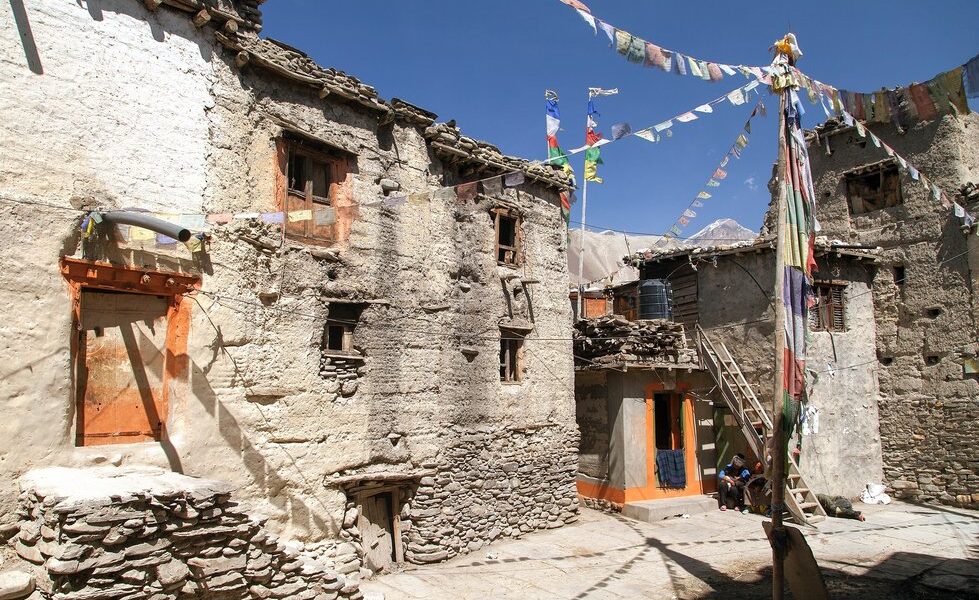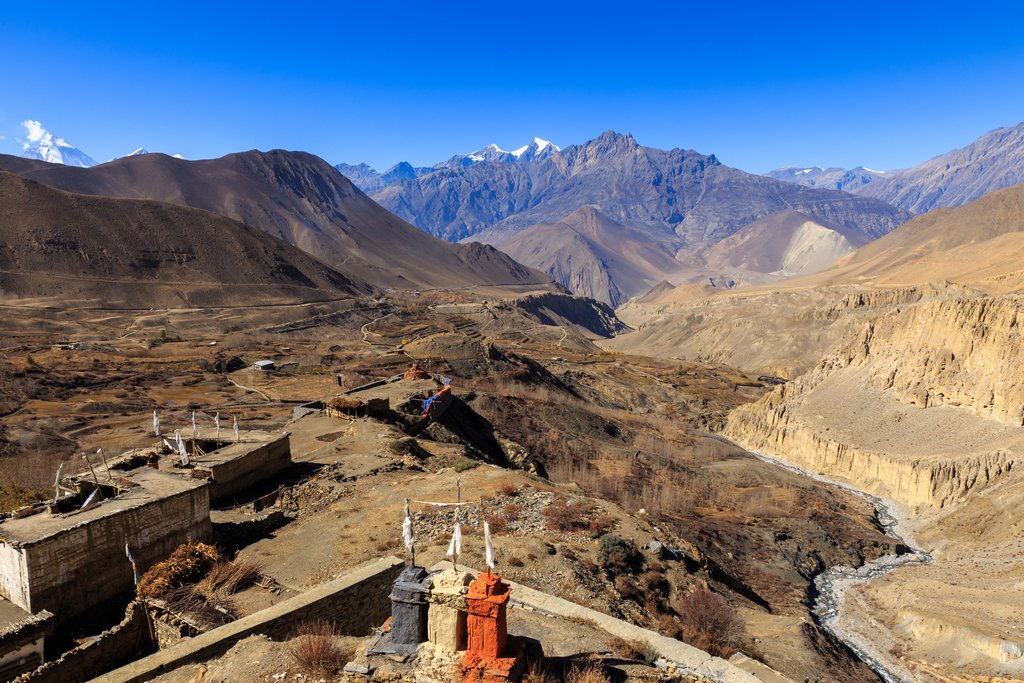
Lower Mustang is a dry, wind-swept region of Nepal that lies in the rain shadow of the Himalayas. If you want to experience some of the most incredible landscapes in Nepal and enjoy challenging, scenic hikes without the strain of a multi-day trek, then several days spent around Jomsom and Kagbeni are an ideal choice.
## Highlights of Lower Mustang: An Unforgettable Nepali Adventure
* Immerse yourself in the rich Tibetan Buddhist culture and stunning architecture that defines Lower Mustang.
* Embark on exhilarating hikes through some of Nepal’s most breathtaking and awe-inspiring scenery, a visual feast for the soul.
* Enjoy the comfort and convenience of well-appointed home bases in both Jomsom and Kagbeni, providing a perfect launching pad for your explorations of the surrounding area.
* Venture on a unique and fascinating fossil hunt, searching for ancient, fossilized sea creatures at an astounding 3000 meters high in the majestic mountains.
* Discover and experience the wonders of this ancient kingdom without the need for the expensive permit required for the more exclusive Upper Mustang.
## **An In-Depth Exploration of Lower Mustang**
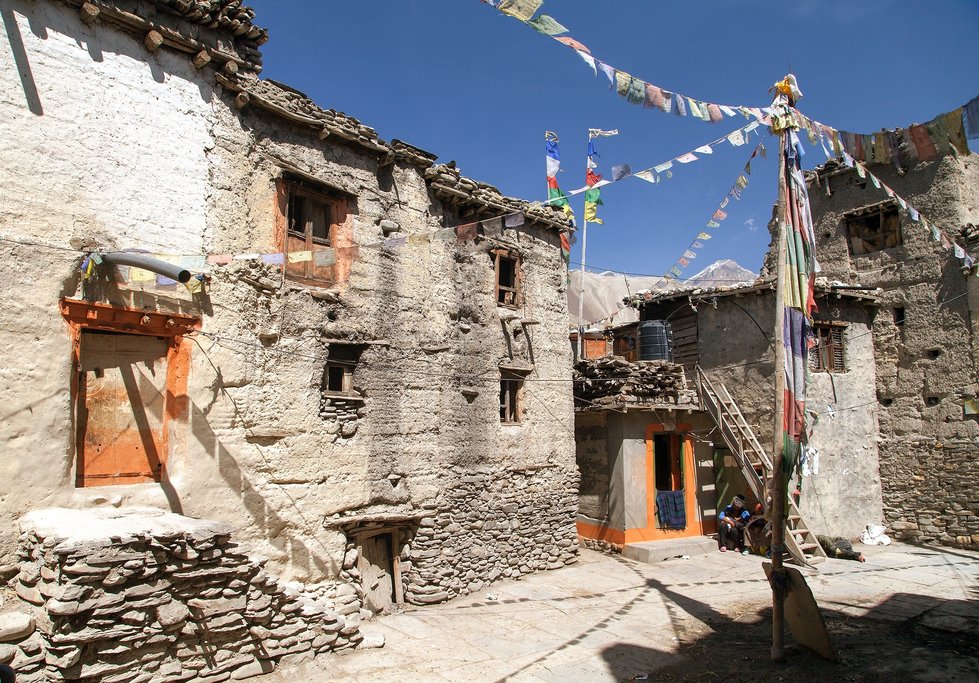
Nestled within the heart of Nepal, the captivating Lower Mustang region occupies a prime location along the renowned Annapurna Circuit. Furthermore, it serves as the gateway to the enigmatic and alluring Upper Mustang. However, Lower Mustang deserves far more recognition and appreciation as a remarkable destination in its own right. By dedicating anywhere from four days to a full week to exploring this region, you’ll have the opportunity to partake in a series of unforgettable day hikes, marvel at the extraordinary and arid landscapes situated in the rain shadow of the towering Himalayas, and immerse yourself in the vibrant Tibetan Buddhist culture of the local Gurung people, gaining insights into their unique way of life.
Jomsom, acting as the primary gateway to Lower Mustang, is characterized as a singular street town boasting an array of lodges catering to diverse budgets, from modest and affordable options to accommodations offering premium comfort. (Surprisingly, you can even find and savor the delights of Himalayan Java coffee in this remote locale!) Kagbeni, located approximately an hour’s drive or a three-to-four-hour hike from Jomsom, offers a more enchanting and atmospheric experience. This medieval town is replete with historical charm, featuring a crumbling palace that whispers tales of bygone eras, an ancient monastery holding centuries of spiritual significance, traditional mud-walled homes that blend seamlessly with the landscape, and narrow, winding lanes adorned with prayer wheels that invite contemplation and reflection. A well-structured itinerary would involve spending a couple of nights in Jomsom to acclimate and prepare, followed by a more extended stay in Kagbeni to fully absorb its cultural richness and serene ambiance.
The weather conditions in Mustang are largely dictated by powerful winds that consistently intensify around 11 am each day. During the cooler seasons, these winds can transform into bitterly cold gusts, requiring careful planning and preparation. It is strongly advised to structure your daily activities to avoid the brunt of the afternoon winds, necessitating early morning starts to maximize your time and comfort. Consider packing layers of warm clothing and windproof gear to mitigate the effects of the harsh elements.
Another exceptional method for experiencing the wonders of the Lower Mustang region is to embark on an exhilarating mountain biking adventure, allowing you to traverse the rugged terrain and explore hidden corners at your own pace.
## Marpha: A Picturesque Oasis
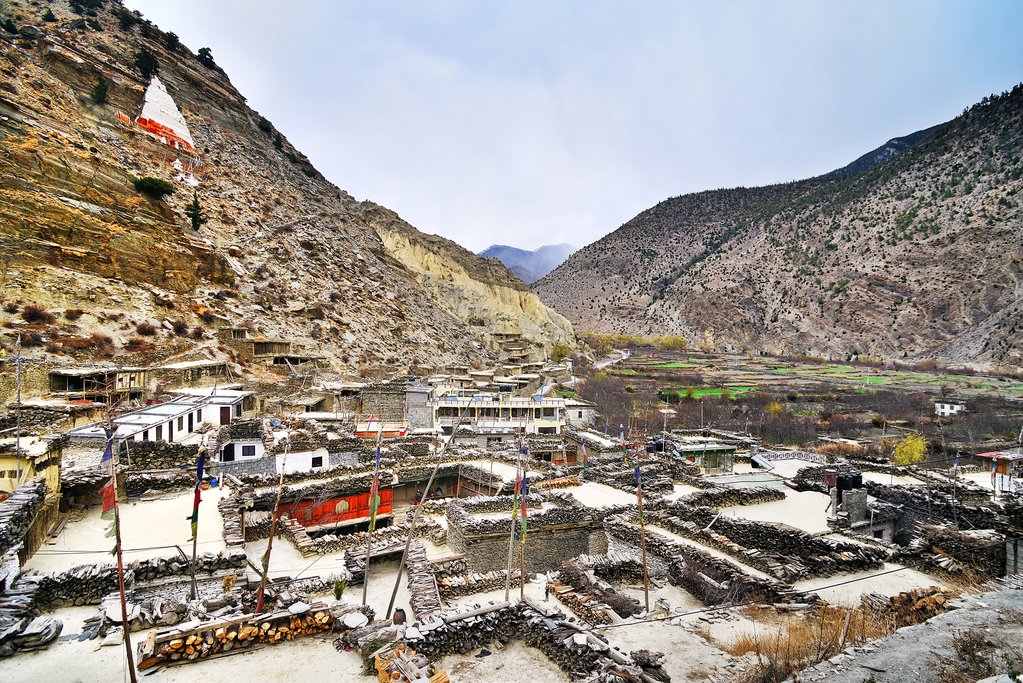
A highly recommended half-day excursion from Jomsom involves a visit to the captivating Marpha village, situated at an elevation of 8,759 ft (2,670 m). To reach Marpha, embark on a leisurely walk south from Jomsom along the main road (which typically experiences minimal traffic) and continue for approximately 90 minutes. The pathway leading to Marpha is clearly defined, following a vehicle road that runs parallel to the scenic Kali Gandaki river. Marpha is a remarkably clean and visually appealing town, characterized by its intricate network of paved canals that provide essential irrigation to the surrounding lush orchards.
The round-trip hike from Jomsom to Marpha encompasses a total of three hours, not accounting for the time spent exploring Marpha itself and indulging in local culinary delights. Be sure to savor a slice of the town’s renowned apple pie (an absolute must-try) or sample the locally produced cider and brandy, both of which are highly acclaimed. From Marpha, clearly marked signs guide you toward the path leading to Dhaulagiri Base Camp, providing an opportunity for more ambitious trekking endeavors. Furthermore, Marpha boasts several lodges, offering an alternative option to Jomsom for your initial overnight stay in Lower Mustang. This allows you to experience the distinct charm and tranquility of Marpha before proceeding with your onward journey.
## Muktinath: A Sacred Pilgrimage Site
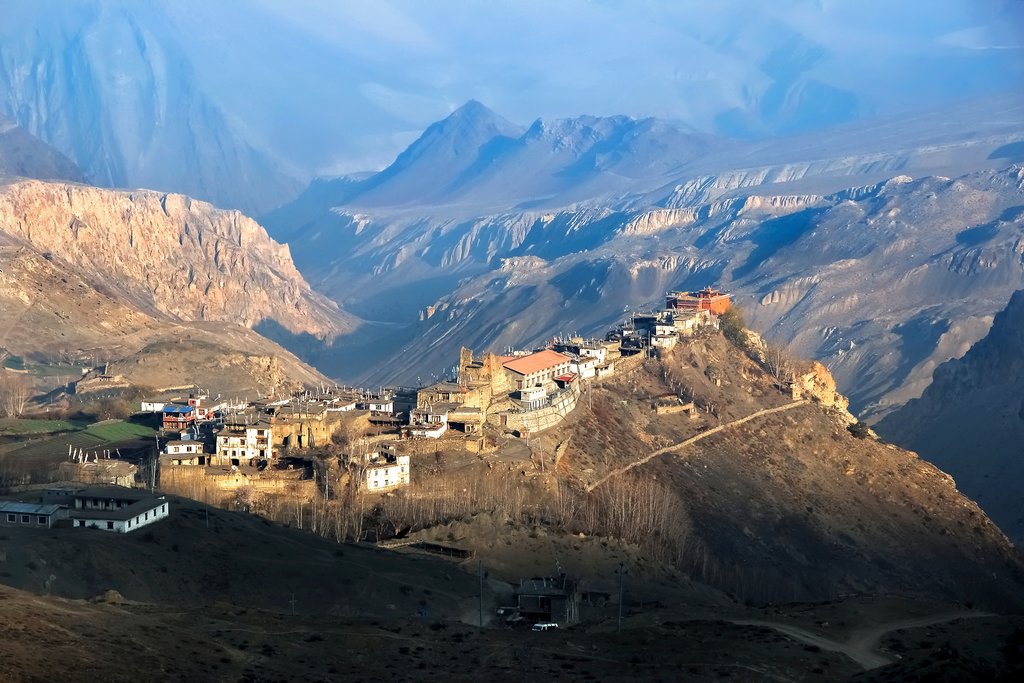
From Kagbeni, a rewarding five-hour round-trip hike will lead you to the sacred site of Muktinath, perched at an altitude of 12,303 ft (3,750 m). Muktinath Temple holds profound religious significance for both Hindus and Buddhists, attracting a large influx of pilgrims, particularly those from India. Although a bumpy vehicle road exists, it is generally preferable to follow the smaller, more scenic tracks uphill when hiking to Muktinath. Along the way, you’ll traverse the ancient town of Jharkot (3,550 m./ 11,646 ft.), from which Muktinath is just another hour’s walk away. Provided the weather conditions are favorable, you’ll be treated to breathtaking panoramic views of the majestic Dhaulagiri and Nilgiri Ranges from Muktinath. The focal point of this sacred destination is the temple itself, situated further uphill from the town of Ranipauwa. This small, pagoda-like structure houses holy fire and holy water, both of which are considered essential elements in the spiritual practices conducted here. The temple exudes an aura of serenity and reverence, making it a truly memorable experience.
### Tiri: A Glimpse into Rural Life
The walk to Tiri, situated at an elevation of 9,186 ft (2,800 m), from Kagbeni typically takes between 30 and 45 minutes. To reach Tiri, simply cross the bridge in Kagbeni and follow the only path heading north, towards the verdant terraced farmland that punctuates the landscape. This path is unpaved and can be somewhat rough, but you’ll likely only encounter the occasional motorbike along the way. From the small village of Tiri, ascend the steep path leading to a monastery that offers unparalleled views of the Kali Gandaki river, the stark and rocky hills, the snow-capped Himalayan peaks, and the distant Upper Mustang. As you journey through this region, take note of the distinctive color scheme of the Buddhist chortens found in Mustang, characterized by the prominent use of white, red, and blue-gray. These colors are unique to this region and add to the visual splendor of the landscape.
### Lubra: A Bon Village of Ancient Traditions
Lubra, situated at an altitude of 9,750 ft (2,972 m), is a Bon village renowned for being the last remaining place in Mustang where the pre-Buddhist Bon religion is still actively practiced. On the hilltop overlooking the town stands what is believed to be the last surviving Bon monastery in Nepal, serving as a testament to the enduring traditions of this ancient faith. Approximately 20 families reside in Lubra, making it a small and intimate community that can only be reached by hiking. As you explore Lubra, you’ll encounter unique cultural traditions woven into the fabric of daily life, such as the colorful string ‘devil traps’ that residents place in their doorways to ward off evil spirits at night. It is possible to arrange an overnight stay in Lubra, providing an opportunity to fully immerse yourself in the village’s unique atmosphere, or you can simply pass through on the trekking route between Kagbeni and Jomsom.
### Meditation Caves & Fossil Hunting: Unearthing Ancient Secrets
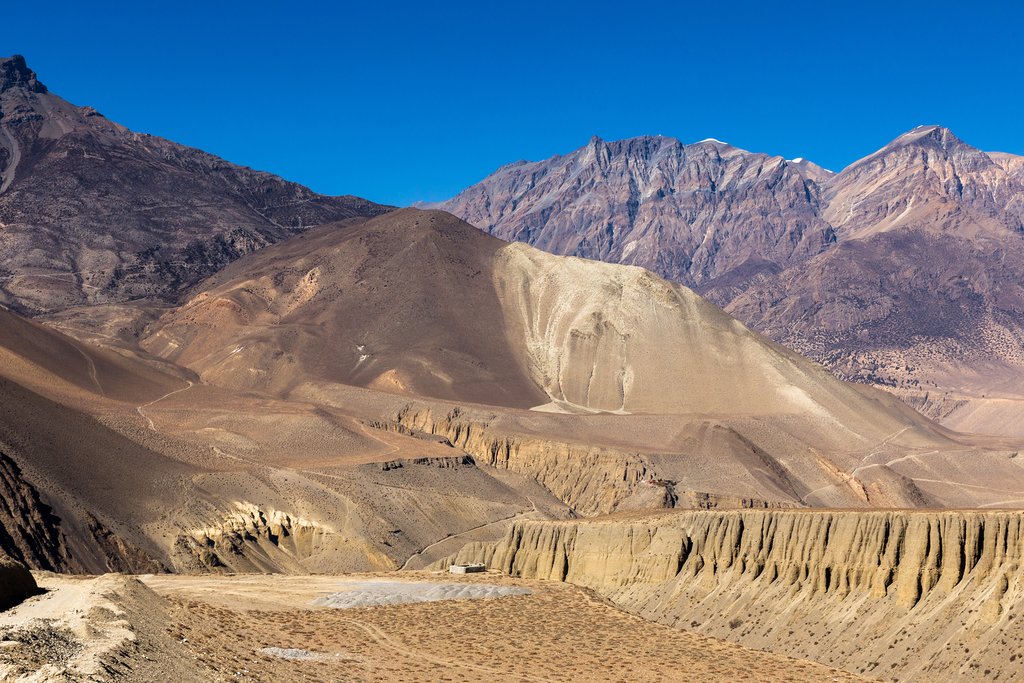
Heading east from Kagbeni, you’ll enter a small valley characterized by remarkable sandstone rock formations that resemble colossal anthills. After approximately 90 minutes of walking, largely following the course of the small river, you’ll arrive at the site of an abandoned village. Carved into the surrounding cliffs are ancient meditation caves. The exact reasons for the village’s abandonment remain shrouded in mystery, and the identity of those who utilized the caves is unknown, but it is generally believed that the caves served as meditation spaces for the villagers, and the village was deserted due to a natural calamity. From this vantage point, you can discern Jharkot perched atop a high ridge, as well as the Thorung La, a challenging pass that trekkers on the Annapurna Circuit must traverse.
As you hike through this valley, keep an eye out for stone ammonite fossils. These fossils are abundant throughout the Kali Gandaki gorge and serve as tangible reminders of a time long before the Himalayas rose from the earth. The Hindu epic, the Mahabharat, even alludes to Muktinath as the source of these fossils, referring to them as *shaligrams,* symbols of Vishnu.
## **Reaching Lower Mustang and Departing**
From Pokhara, taking a flight is undoubtedly the fastest and most comfortable means of reaching Lower Mustang. Flights are scheduled to depart early in the morning to avoid the strong winds that typically pick up in Mustang by late morning. Despite the brevity of the flight, lasting just twenty minutes, it offers an unforgettable experience as you soar through the dramatic Kali Gandaki Gorge, with the majestic Dhaulagiri and Tukuche mountains looming to the west, and Nilgiri Central and Annapurna gracing the eastern horizon.
Opting for a public bus or private vehicle between Pokhara and Jomsom presents a more ‘adventurous’ alternative, but it can also entail a journey exceeding ten hours along roads that may be less than comfortable.
Trekking the entire distance is also feasible, allowing you to bypass the road by following scenic mountain trails. Lower Mustang is situated along the classic Annapurna Circuit Trek, enabling you to seamlessly integrate these day trips into a more extended trekking itinerary.
## **Ideal Seasons for Exploration**
Due to Mustang’s location in the rain shadow of the Himalayas, its weather patterns differ considerably from those in the rest of Nepal. While the months of May through September are typically wet throughout much of the country, this period can be a favorable time to visit Mustang. However, it’s essential to be aware that flights from Pokhara have a greater probability of being canceled during the monsoon season due to adverse weather conditions on the southern side of the Himalayas. Simultaneously, the roads can become treacherous, with rain rendering them muddy and slippery, increasing the risk of landslides. Alternatively, the spring months (March to May) and the autumn months (September to November) are generally considered excellent times to plan a visit.
The altitude of Mustang results in consistently cooler temperatures. Consequently, the winter months can become uncomfortably cold, particularly when the inevitable winds intensify. It is crucial to pack appropriate warm clothing and be prepared for cold weather if you plan to travel between November and March.
## **Permit Requirements**
While gaining access to Upper Mustang requires a costly permit (approximately $500 for 10 days), this requirement is waived if you remain within Lower Mustang. For the areas encompassing Jomsom, Kagbeni, and Muktinath, a significantly more affordable permit is all that is needed (Rs 2000, or approximately $20 USD). It is advisable to purchase these permits in Kathmandu or Pokhara, as they are substantially cheaper than acquiring them upon arrival, where the cost is often doubled. By obtaining your permits in advance, you can streamline your entry and save valuable travel funds.
*New word count: 1728 words*
B-1788

